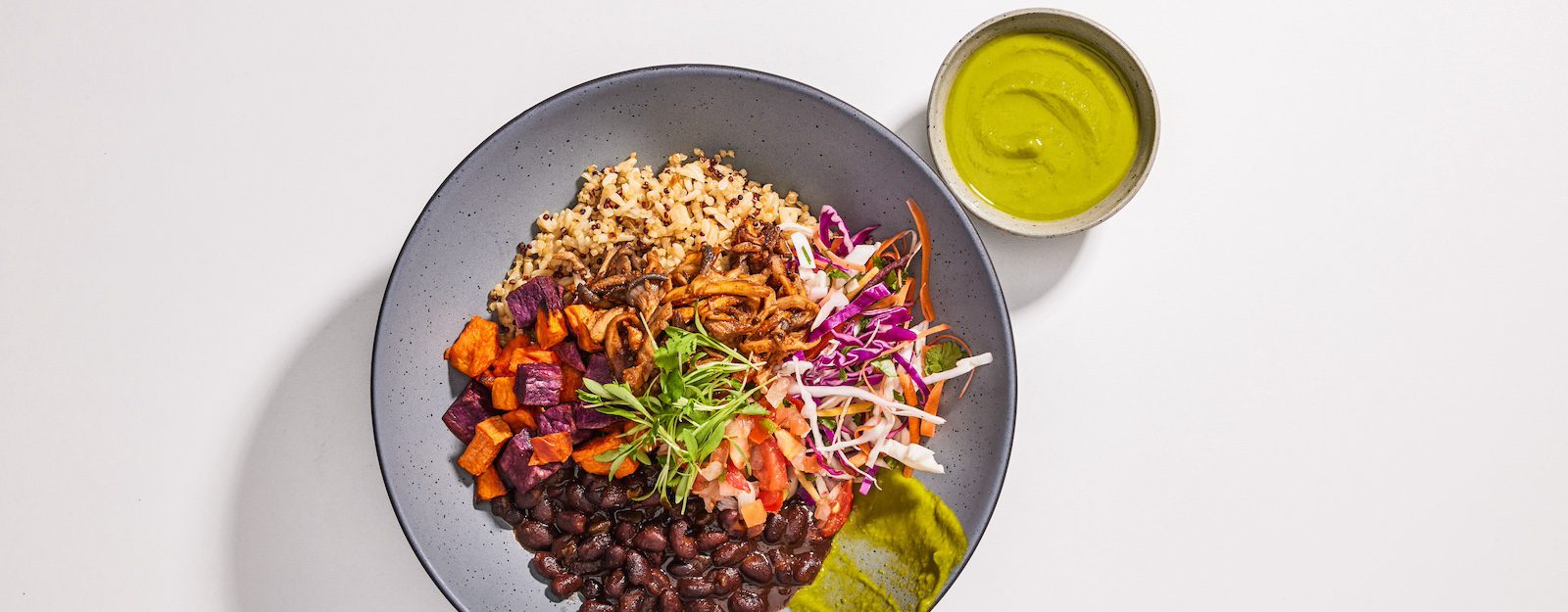The average American dines out 4 to 5 times per week, which means about 25% of calories consumed each week come from restaurants. Eating away from home can have its pitfalls, but there are practical ways to enjoy restaurant meals while still prioritizing optimal nutrition and wellness.
10 Tips to Maximize Nutrition When You Dine Out
- Check out the menu online and pre-decide what to order (it’s harder to make healthy choices when you’re hungry!).
- Eat veggies and/or fruit before you go if you can’t get them (or get enough of them) in your meal. Good choices include raw or leftover roasted veggies, a side salad, a broth-based veggie soup, cut or loose seasonal fruit, or a small apple or pear.
- When ordering, select veggie options first, like salads, veggie sides, and veggie soups, and build your meals around them.
- Opt for plant-based proteins like lentils, black beans, or split peas, tofu, or tempeh. If you eat animal-based foods, lean choices include baked or grilled fish or poultry.
- Include whole food carbohydrates. Go for whole grains over refined grains, like brown or wild rice, quinoa, or roasted corn. Starchy veggies are another great choice, such as roasted fingerling potatoes or sweet potatoes, butternut squash, or root vegetables.
- Look for good fats. These may include a side of avocado or whole olives, or a garnish of nuts or seeds.
- Choose water, sparkling water, or herbal tea for hydration. If you do drink alcohol, stick with moderate amounts, which means no more than one standard drink for women or two for men. One drink means 5 ounces of wine, a 12-ounce beer, or one shot of distilled spirits, like tequila or vodka. If you prefer a cocktail, substitute soda or a sugary mixer with a combo of sparkling water, a splash of 100% fruit juice (like fresh squeezed lime or pomegranate juice), and flavorful all-natural add-ins, like fresh mint or ginger.
- Eat slowly. Put your utensil down between bites, take your time, and savor your food. Tune into your body’s natural hunger and fullness cues and use them to guide your portions (rather than automatically cleaning your plate).
- If you order dessert, choose a can’t-live-without favorite or something that offers key nutrients that also sound satisfying, like an option made with fruit, dark chocolate, or nuts. To limit added sugar consider splitting a dessert with a dining companion. If you already feel full and satisfied, enjoy tea or coffee instead; don’t feel obligated to eat dessert even if everyone else does.
- Take a post-meal walk. Brief 15-minute post-meal walks have been shown to help support healthy blood sugar regulation. It’s also great for digestion and it’s a nice way to get outdoors and spend a little extra time with your dining partner(s).
| Pros of Dining Out | Cons of Dining Out |
| It’s a chance to enjoy social time with friends, family, or co-workers. | It’s typically more expensive than cooking at home. |
| Great opportunity to try new healthy dishes, like vegetables and plant-based ethnic cuisines. | Restaurant meals tend to be much higher in sodium, oil, and added sugar. |
| It can be healthier than convenience foods you might eat at home, like frozen dinners. | You have less control over how your food is made, as far as ingredients, types of oils used, cooking techniques, and portions. |
Alternatives Based on Why You Dine Out
| Instead of Going Out to Eat as A Social Activity | Instead of Dining Out for Convenience | Instead of Dining Out to Celebrate |
| Plan non-food activities with others: Go for a walk, hike, or bike ride. Plan a card game or board game night. Organize a game of tennis, basketball, volleyball, racquetball, catch, pickleball, etc. Go bowling, fowling, or ax throwing. See a movie or play. Start a book club. Learn a new hobby with others, such as croqueting, painting, pottery making, or knitting. Take a language class. Take a yoga, meditation, or exercise class. Go shopping. Volunteer. Have a bonfire. Go to a comedy show or ballet. Go to trivia night or karaoke/open mic night. Do an escape room. Go putt-putting or to an arcade. Go to a local fair or festival. Go to an amusement park or water park. Go to a professional or minor league sports game. | Opt for quick and easy make-at-home meals. | Consider non-food ways to celebrate: Treat yourself to a massage or other self-care activity. Plan a picnic at a favorite outdoor spot. Buy tickets to a fun event, like a concert or musical. Take a few hours to enjoy a museum or art exhibit. Plan a mini vacation or staycation. Enjoy ‘you time’ to read, take a nap, or take a bath. Go dancing, take a dance class (or dance in your living room). Buy yourself fresh cut flowers or a new plant. Go skiing, snowboarding, or skating. Go surfing, swimming, or walk on the beach. Go to the zoo or aquarium. Go horseback riding. Go rock-climbing. Do a puzzle. Go roller skating. Go kayaking or canoeing. Garden. Go on a scenic drive. Go to the driving range. Do archery. |
Ethnic Cuisines and Healthy Dishes to Look For
Although these dishes are typically plant-based, sodium, sugar, or fat may be added – especially in sauces. Don’t be afraid to ask your wait staff for more information about a dish before you order to clarify how it’s made.
- East Asian Inspired
- Gỏi cuốn chay – Vietnamese vegetable summer rolls (not fried)
- Vegetable sushi (avoid tempura)
- Sekihan (Japanese) / Parbap (Korean) / hóngdòu fàn (Chinese) – beans and rice
- Vegetarian stir fry (ask for sauce on the side or without)
- Vegetable Thai dish (be cautious of sauce)
- Kimchi – Korean fermented cabbage and other vegetables
- Boribap – Korean rice and barley with vegetables
- South Asian Inspired
- Aloo gobi – potato and cauliflower curry
- Chana masala – chickpea tomato curry dish
- Rajma chawal – red kidney bean curry dish (ask if made with cream)
- Dal bhat – lentils and rice
- Latin Inspired
- Moros y Cristianos – Cuban beans and rice dish
- Vegetable bean bowl
- Black bean tacos or burritos (load up with vegetables!)
- Mediterranean Inspired
- Louvi – black eyed bean salad
- Tabbouleh – Lebanese, herb-based salad
- Briam – roasted vegetable dish
- Spanakorizo – Greek spinach and rice dish
- Hummus with vegetables or pita
- Baba ghanoush with vegetables or pita – roasted eggplant dip
- Middle Eastern Inspired
- Imam bayildi – Turkish stuffed eggplant
- Mujadara – lentil and onion grain dish
- Ful medames – fava bean stew
- Italian Inspired (consider asking for dishes without protein additions or cheese and be cautious of added creams to sauces)
- Spaghetti alla puttanesca – vegetable pasta dish (usually with oil)
- Marinara (cautious of added sugars and sodium)
- Aglio e Olio aka Spaghetti with garlic (ask for low or no added parmesan and oil free)
- Fra diavolo – spicy red sauce
- Lemon sauce
- Pesto pasta
- French Inspired
- Ratatouille – roasted vegetable dish
- African Inspired
- Zaalouk – Moroccan eggplant, tomato salad
5 Tips if Weight Loss is a Goal
- Ask for a window seat at a table away from the kitchen and bar. Studies show that people who sit in these locations consume less food, drink fewer alcoholic beverages, and don’t feel as hungry.
- Skip the bread or pre-meal chips. In addition to the extra calories, research has shown that eating bread stimulates your appetite, so you’ll likely eat and order more food than you need.
- Eat a high-fiber food first, like salad or an appetizer of veggies with hummus. This will fill you up and help prevent a blood sugar spike.
- Reduce portions by making an appetizer or a few side dishes for your meal rather than a large entrée.
- It takes 20 minutes for you to feel full, so try not to rush through your meal. Take smaller bites, chew slowly, and savor your food.
Quick Tip
Build a list of healthy go-to restaurants in your area. Ask friends or family members who share similar health goals for recommendations. Check the internet, social media, and travel guides for ideas. Search for “healthy restaurant” in your city, as well as terms like “farm to table,” “whole food,” and “plant-based.” You can also try phone apps for healthy options, like Happy Cow. Or search for healthy options within apps, like Uber Eats and Grub Hub. Save your favorite restaurants and orders so you’ll have them at the ready.
Did You Know?
According to the CDC, on average, fast food meals contain 1,848 mg of sodium and dine-in restaurant meals pack 2,090 mg of sodium per 1,000 calories eaten? That means just one meal ordered away from home nearly hits or exceeds the maximum recommended daily sodium limit depending on the calorie level. Excess sodium has been shown to up the risk of high blood pressure and stroke. If you dine out frequently this is one key reason to consider cutting back.
Quick Tip
For more nutritious meals avoid dishes with these menu descriptors:
- Fried
- Pan-fried
- Alfredo
- Smothered
- Crispy
- Dipped
- Scalloped
- Loaded
- Deep fried
- Gratin
- Buttery
- Cheesy
- Creamy

